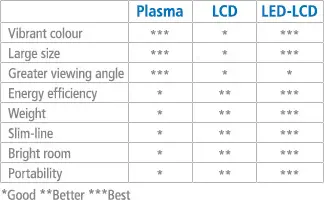Difference between LCD and Plasma TV sets ?

Outward appearances are definitely deceiving when it comes to LCD and Plasma televisions. Although both types of televisions are flat and thin, they employ different technology in an attempt to deliver similar results.
The ADVANTAGES of Plasma over LCD are:
1. Larger screen size availability.
2. Better contrast ratio and ability to render deeper blacks.
3. Better color accuracy and saturation.
4. Better motion tracking (little or no motion lag in fast moving images).
The DISADVANTAGES of Plasma vs LCD include:
1. Plasma TVs are more susceptible to burn-in of static images. However, this problem has diminished greatly in recent years as a result of the incorporation "pixel orbiting" and related technologies.
2. Plasma TVs generate more heat than LCDs, due to the need to light of phosphors to create the images.
3. Does not perform as well at higher altitudes.
4. Potentially shorter display life span – this used to be the case. Early Plasmas had 30,000 hours or 8 hrs of viewing a day for 9 years, which was less than LCD. However, screen life span has now improved and 60,000 hour life span rating are now common, with some sets rated as high as 100,000 hours, due to technology improvements.
LCD television ADVANTAGES over Plasma include:
1. No burn-in of static images.
2. Cooler running temperature.
3. No high altitude use issues.
4. Increased image brightness over Plasma, which makes LCD TVs better for viewing in brightly lit rooms.
5. Lighter weight (when comparing same screen sizes) than Plasma counterparts.
6. Longer display life used to be a factor, but now LCD and Plasma sets both have at least 60,000 hour or higher lifespans.
DISADVANTAGES of LCD vs Plasma televisions include:
1. Lower contrast ratio, not as good rendering deep blacks, although the increasing incorporation of LED backlighting has narrowed this gap.
2. Not as good at tracking motion (fast moving objects may exhibit lag artifacts) – However, this is improving with the recent implementation of 120Hz screen refresh rates and 240Hz processing in higher-end LCD sets.
3. Not as common in large screen sizes above 42-inches as Plasma. However, the number is growing fast, with 46 and 47-inch screen sizes becoming more common, and some LCD sets having a screen size as large as 65-inches also available to the general public.
4. Although LCD televisions do not suffer from burn-in susceptibility, it is possible that individual pixels on an LCD televisions can burn out, causing small, visible, black or white dots to appear on the screen. Individual pixels cannot be repaired, the whole screen would need to be replaced at that point, if the individual pixel burnout becomes annoying to you.
5. LCD televisions are typically more expensive than equivalent-sized Plasma televisions (although this is changing).















